La mexilla
Mexilla is the name by which the mussel seed is known among mussel farmers in Galicia.
The mexilla (mussel seed between 15 and 25 millimeters in size) necessary for culture is obtained from the rocks of the coast or from collector ropes that are hung in the rafts between the months of March and October, and are kept submerged during the season. of reproduction of the mussel, allowing the fixation on them of the larvae. Early collector seed is available from July for handling. The rock seed, although depending on the year, begins to be collected and placed on the cultivation ropes from November.
The mexilla needs are estimated at around 7,000 tons (Tm) per year, to obtain an annual harvest of 250,000 Tm of mussels. In most of the rafts, exclusively seed from the rocks is used (66%). In the other rafts, rock seed alternates with collector seed, and only a part of the growers exclusively use this last type of seed due to its scarcity.
The mussel aquaculture sector in Galicia is a sector with great socioeconomic relevance, producing an annual average of 250,000 tons of mussels per year, which makes Galicia the main European mussel producer and makes it alternate between the second and third position of world production. This culture is based on the collection of juveniles (seed or mexilla) from the natural environment, mainly by extracting them from the rocky intertidal. The extraction of mussel seed from natural banks is regulated by the Order of October 26, 2000 (DOG no. 228 of November 24), which limits its use to the supply of the culture, as well as establishes periods (December 1 to April 30) and maximum quantities to be extracted (3500 kg per raft), its extraction being restricted only in the Illas Atlánticas National Park until 2021.

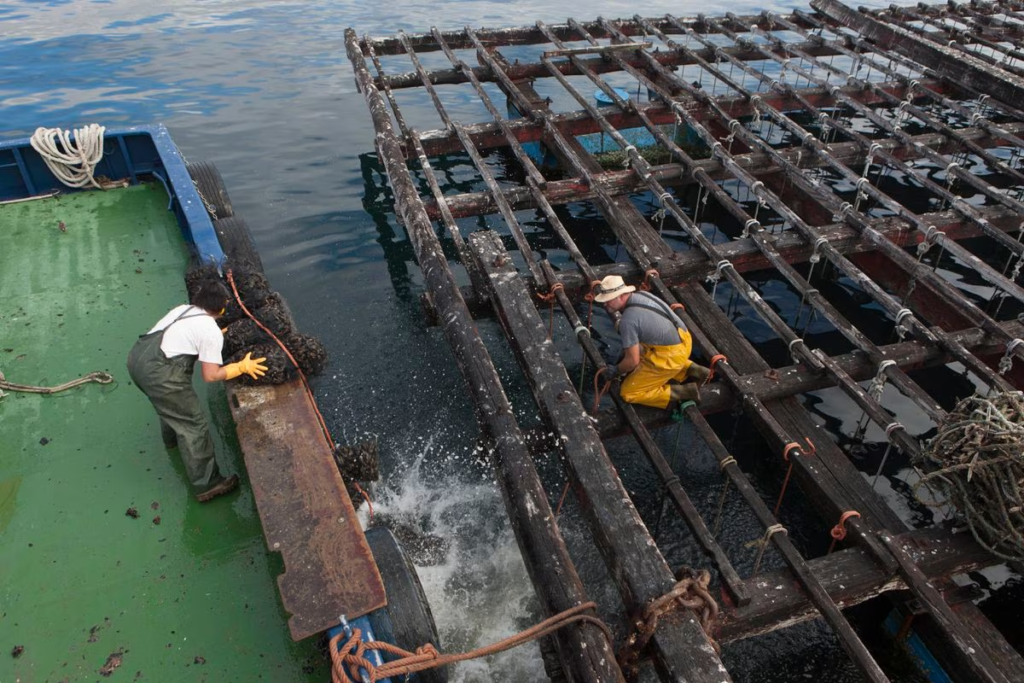
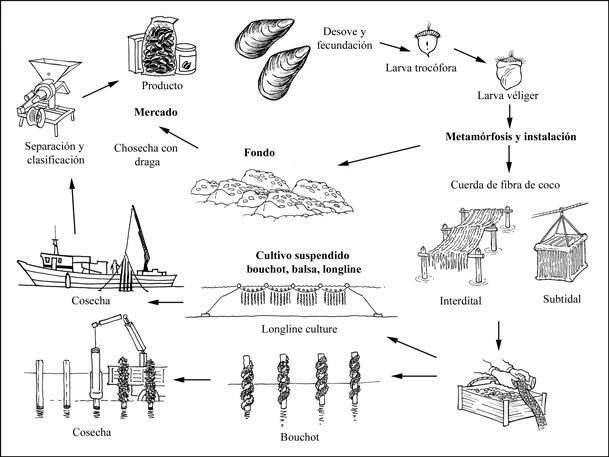

 The cultivation begins when the growers obtain the seed, mainly from the natural populations (60-70%) and the rest of the cords that they place as collectors in the trays themselves. In the months of December to April the growers take off with scrapers on the roughest rocks of the coast, the mussel seed.
The cultivation begins when the growers obtain the seed, mainly from the natural populations (60-70%) and the rest of the cords that they place as collectors in the trays themselves. In the months of December to April the growers take off with scrapers on the roughest rocks of the coast, the mussel seed.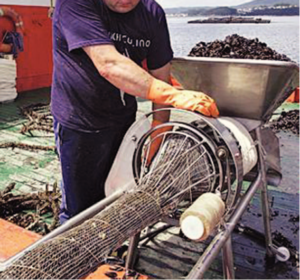 Growers place the seed on the ropes by hand or by using a machine that wraps them in cotton or rayon netting; this network disintegrates in a few days. By then the mussels have produced a new byssus and have attached themselves to the string. Growers usually place 1.5 to 1.75 kg of seed per meter of string, with the average weight of a string of seed being 14 kg. The ropes, normally 3 cm thick, are made of nylon, polyethylene or esparto grass (S. junceum), their length ranges from 6 to 10 meters. Its rough surface makes it easy to fix the mussels. Each rope with attached mussels has a loop at the end, which is attached to a thinner polyester rope called a “rabiza” (12-14 mm thick), which in turn is attached to the tray. The rabiza has an average life of about 3-4 years since it is exposed to the air and the sun (Figueras, 1989), while the large rope lasts an average of 5.8 years. Each punt has 200 to 700 strings. Every 30-40 cm, wooden or plastic sticks are placed between the strands of the rope to prevent groups of mussels from detaching. Growers place 1 to 3 cuerdas per m² of raft surface. This distribution allows an adequate flow of nutrient-rich water for the mussels, preventing the ropes from touching each other. Growers place the ropes mainly from November to March.
Growers place the seed on the ropes by hand or by using a machine that wraps them in cotton or rayon netting; this network disintegrates in a few days. By then the mussels have produced a new byssus and have attached themselves to the string. Growers usually place 1.5 to 1.75 kg of seed per meter of string, with the average weight of a string of seed being 14 kg. The ropes, normally 3 cm thick, are made of nylon, polyethylene or esparto grass (S. junceum), their length ranges from 6 to 10 meters. Its rough surface makes it easy to fix the mussels. Each rope with attached mussels has a loop at the end, which is attached to a thinner polyester rope called a “rabiza” (12-14 mm thick), which in turn is attached to the tray. The rabiza has an average life of about 3-4 years since it is exposed to the air and the sun (Figueras, 1989), while the large rope lasts an average of 5.8 years. Each punt has 200 to 700 strings. Every 30-40 cm, wooden or plastic sticks are placed between the strands of the rope to prevent groups of mussels from detaching. Growers place 1 to 3 cuerdas per m² of raft surface. This distribution allows an adequate flow of nutrient-rich water for the mussels, preventing the ropes from touching each other. Growers place the ropes mainly from November to March. The third step is the unfolding. This operation is intended to prevent the mussels from falling off the rope in times of bad weather, and also allows them to grow quickly and evenly. Farmers carry out this operation when the mussels are half grown (shell length 4-5 cm) when they have reached 5-6 months in size, normally from June to October. The average weight of the ropes has increased by around 50 kg. The ropes are transferred to the boats using a crane and the groups of mussels are rubbed on a table with a sieve made of steel bars that allows them to be separated into different sizes. A cylindrical strainer can also be used. With this operation, it is possible to prepare 3 or 4 ropes from each original rope using the cotton or rayon netting already described above. The average weight of the ropes is 46 kg. Those growers who have automated this operation spend 5 to 15 seconds per meter of rope, or less than 14 hours to prepare 500 10-meter-long ropes. If the mussels grow very quickly and their weight can cause them to slip off the rope, this operation is repeated. It is also often done when growers want all mussels to be a similar size at harvest time.
The third step is the unfolding. This operation is intended to prevent the mussels from falling off the rope in times of bad weather, and also allows them to grow quickly and evenly. Farmers carry out this operation when the mussels are half grown (shell length 4-5 cm) when they have reached 5-6 months in size, normally from June to October. The average weight of the ropes has increased by around 50 kg. The ropes are transferred to the boats using a crane and the groups of mussels are rubbed on a table with a sieve made of steel bars that allows them to be separated into different sizes. A cylindrical strainer can also be used. With this operation, it is possible to prepare 3 or 4 ropes from each original rope using the cotton or rayon netting already described above. The average weight of the ropes is 46 kg. Those growers who have automated this operation spend 5 to 15 seconds per meter of rope, or less than 14 hours to prepare 500 10-meter-long ropes. If the mussels grow very quickly and their weight can cause them to slip off the rope, this operation is repeated. It is also often done when growers want all mussels to be a similar size at harvest time.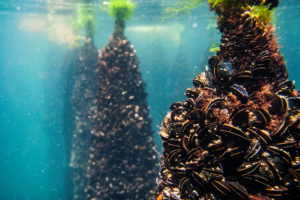 In Galicia, growth is rapid, especially in the areas of the estuaries close to the ocean, being able to reach commercial size (8-10 cm) in 8 or 9 months, although normally, the time necessary to reach commercial size is 13 months. . However, if the density of rafts is high, this growth can slow down. In summer growth is minimal, while winter is the time of greatest growth. This low growth detected in summer is related to the scarcity of plankton in the stratified water, being more important than the effect of temperature that makes spring and autumn spat have the same size at the end of the first winter.
In Galicia, growth is rapid, especially in the areas of the estuaries close to the ocean, being able to reach commercial size (8-10 cm) in 8 or 9 months, although normally, the time necessary to reach commercial size is 13 months. . However, if the density of rafts is high, this growth can slow down. In summer growth is minimal, while winter is the time of greatest growth. This low growth detected in summer is related to the scarcity of plankton in the stratified water, being more important than the effect of temperature that makes spring and autumn spat have the same size at the end of the first winter.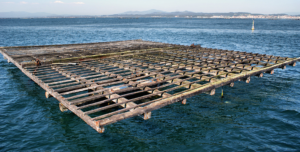 In Galicia there are mussels of commercial size throughout the year and can be harvested at any time. The peak harvest time is from October to March when the market demand is greatest and the condition of the root vegetables is the best. The weight of the mussel meat can reach 50% of the total weight at the moment of best condition. When a high percentage of mussels have spawned or are close to spawning, harvesting must wait until they are in better condition. The average production per m² of raft reaches 130 kg and for a whole raft the production oscillates between 20 and 100 t, with an average value of 47 t, these values being highly variable. Another production data is that each meter of rope can produce around 10 kg of mussels. Annual losses (natural mortality and management) have been estimated at 15%. Recently, the results of experimental mussel cultures show that mortality is around 5%.
In Galicia there are mussels of commercial size throughout the year and can be harvested at any time. The peak harvest time is from October to March when the market demand is greatest and the condition of the root vegetables is the best. The weight of the mussel meat can reach 50% of the total weight at the moment of best condition. When a high percentage of mussels have spawned or are close to spawning, harvesting must wait until they are in better condition. The average production per m² of raft reaches 130 kg and for a whole raft the production oscillates between 20 and 100 t, with an average value of 47 t, these values being highly variable. Another production data is that each meter of rope can produce around 10 kg of mussels. Annual losses (natural mortality and management) have been estimated at 15%. Recently, the results of experimental mussel cultures show that mortality is around 5%.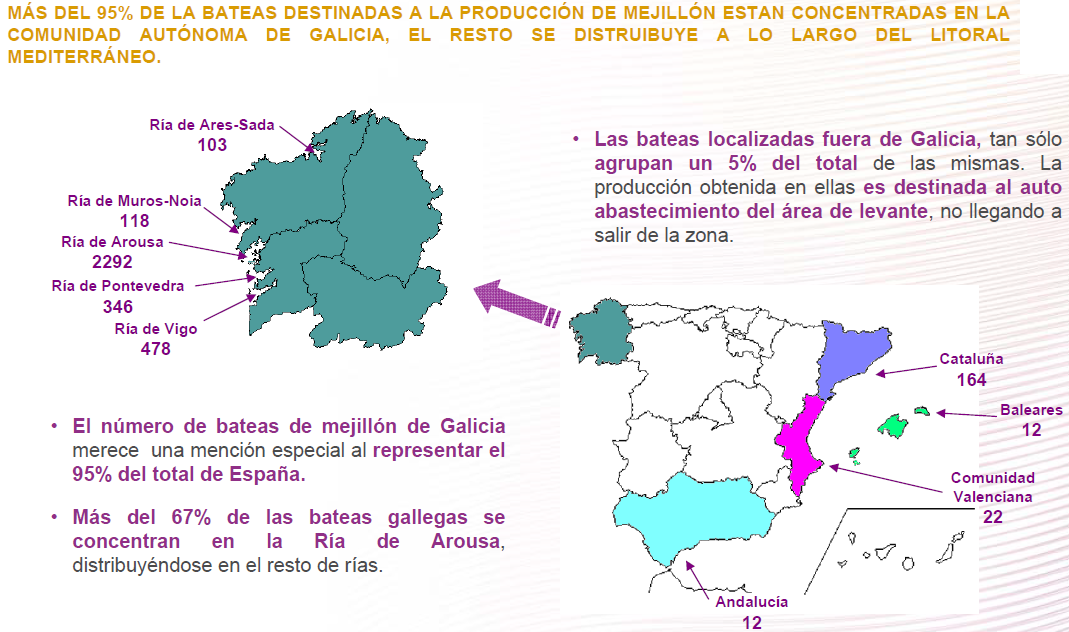 To harvest the mussels, the farmers use a crane to hoist the ropes onto their boats, where the mussels are separated and graded on a sieve table. Small mussels, slime, empty shells, sea squirts and other accompanying organisms are removed. Small mussels are once again used in farming. The commercial size ones are packed in nylon bags and sent to purification plants.
To harvest the mussels, the farmers use a crane to hoist the ropes onto their boats, where the mussels are separated and graded on a sieve table. Small mussels, slime, empty shells, sea squirts and other accompanying organisms are removed. Small mussels are once again used in farming. The commercial size ones are packed in nylon bags and sent to purification plants.